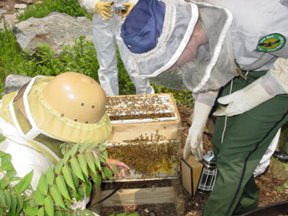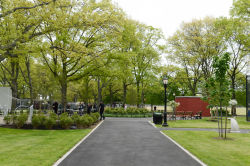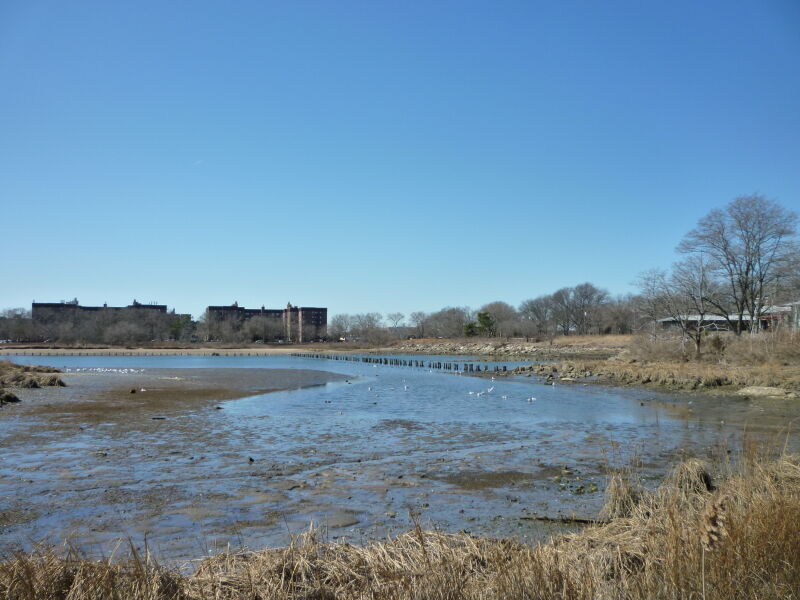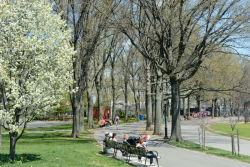Marine Park
The Daily Plant : Monday, July 19, 2004
JUST BUZZING AROUND? CHECK OUT MARINE PARK’S NEW OBSERVATION BEEHIVE

Visitors to the Salt Marsh Nature Center at Marine Park in Brooklyn are in for a treat this month with the addition of a new observation beehive.
The beehive, which was installed by the Sweet Pines Apiary, is a wooden hutch with a glass windowpane on the top. The structure is three feet long, two feet wide, and four feet high. "It’s the perfect height for kids to see what’s going on inside," said Urban Park Ranger Sergeant Lynda Miller.
What kids (and adults) will see inside are the workings of a busy bee society. The observation window makes it possible to watch as worker bees construct the honey comb structure of the hive. Amidst the bustle of the hive, one can easily spot the queen bee, marked by the Rangers with a green dot to distinguish her from the workers. Each year, the new queen will be marked with a different color as a record of the history of the hive.
The hive, which comes equipped with plastic tubing leading outside of the nature center so that the bees can access the plethora of wildflowers in the surrounding salt marsh, can house from 8,000 to 10,000 bees. The bees quickly become an integral part of the ecosystem. As they collect nectar from the butterfly bush, coreopsis, thistle, clover, and aster near the nature center, they will also pollinate these flowers and eventually help boost the wildflower population.
In addition to its benefits to the ecosystem, the observation beehive is a valuable educational tool. Specifically, it is used for the Urban Park Rangers Entomology Program, "Buggin’ Out". In addition, all visitors to the nature center can check out what the bees are up to everyday, and the response so far has been enthusiastic. "The kids are loving it!" Sergeant Miller said.
A beehive is a bustling place, and this beehive is no exception. Worker bees, young females, keep the colony running. They collect nectar from flowers to make the honey that will feed the queen and larvae back at the hive. They also produce the wax comb that structures the hive itself. Some worker bees have the seemingly easy job of guarding the hive and keeping it cool, but the 11,400 times a minute they beat their wings to keep the temperature down means they do not have much time to rest.
All the male bees in the hive are called drones, and their sole purpose in life is to mate with the queen. Not even equipped with stingers, they are the first to be booted out of the hive when resources are running low.
All of the activity of the hive revolves around the one queen bee. The workers select the queen as a two-day-old larva, and at eleven days she mates with approximately 18 drones. Then for the rest of her two-year life span, she lives with relative ease as she lays anywhere from 10 to 3,000 eggs a day.
The Marine Park Salt Marsh Nature Center observation beehive provides a chance to look into the fascinating world of bees firsthand, and it is definitely worth the trip to Marine Park just to get a glimpse of the queen bee. Now anyone can get a chance to see royalty in the parks.
For more information about Marine Park, please visit our website, www.nyc.gov/parks, or call the City’s non-emergency hotline, 311.
Written by Rebecca Silverstein
QUOTATION FOR THE DAY
"Edible, adj.: Good to eat, and wholesome to digest, as a worm to a toad, a
toad to a snake, a snake to a pig, a pig to a man, and a man to a worm."
Ambrose Bierce
(1842-1914)
Check out your park's Vital Signs
Clean & Safe
Green & Resilient
Empowered & Engaged Users
Share your feedback or learn more about how this park is part of a
Vital Park System










